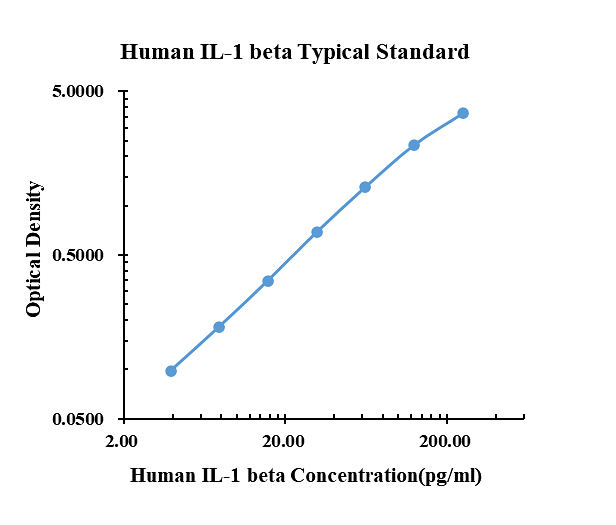Human IL-1β enzyme-linked immunoassay kit
| Specification | 96 Test |
|---|---|
| Sensitivity | 0.18 pg/ml (10 μl);0.09 pg/ml (50 μl); |
| Standard Curve Range | 3.91~250 pg/ml |
| Standard Curve Gradient | 7 Points |
| Number of Incubations | 2 |
| Detectable sample | Liquid phase sample of soluble substances. For example: serum, plasma, cell culture supernatant, tissue grinding liquid, etc. |
| Sample Volume | 10 μl/50 μl |
| Type | Ready-to-Use |
| Operation Duration | 120min |

| pg/ml | O.D. | Average | Corrected | |
|---|---|---|---|---|
| 0.00 | 0.0296 | 0.0307 | 0.0302 | |
| 3.91 | 0.1330 | 0.1232 | 0.1281 | 0.0980 |
| 7.81 | 0.2132 | 0.2122 | 0.2127 | 0.1826 |
| 15.63 | 0.3820 | 0.3760 | 0.3790 | 0.3489 |
| 31.25 | 0.7406 | 0.6980 | 0.7193 | 0.6892 |
| 62.50 | 1.3710 | 1.2880 | 1.3295 | 1.2994 |
| 125.00 | 2.4490 | 2.3060 | 2.3775 | 2.3474 |
| 250.00 | 3.7620 | 3.6230 | 3.6925 | 3.6624 |
Precision
| Intra-assay Precision | Inter-assay Precision | |||||
| Sample Number | S1 | S2 | S3 | S1 | S2 | S3 |
| 22 | 22 | 22 | 6 | 6 | 6 | |
| Average(pg/ml) | 6.0 | 29.6 | 93.7 | 7.2 | 33.6 | 104.4 |
| Standard Deviation | 0.3 | 1.3 | 4.1 | 0.3 | 1.0 | 2.0 |
| Coefficient of Variation(%) | 4.8 | 4.5 | 4.4 | 4.1 | 2.9 | 1.9 |
Intra-assay Precision (Precision within an assay) Three samples of known concentration were tested twenty times on one plate to assess intra-assay precision.
Inter-assay Precision (Precision between assays) Three samples of known concentration were tested six times on one plate to assess intra-assay precision.
Spike Recovery
The spike recovery was evaluated by spiking 3 levels of human IL-1 beta into health human serum sample. The un-spiked serum was used as blank in this experiment.
The recovery ranged from 85% to 120% with an overall mean recovery of 95%.
Sample Values
| Sample Matrix | Sample Evaluated | Range (pg/ml) | Detectable (%) | Mean of Detectable (pg/ml) |
|---|---|---|---|---|
| Serum | 30 | 1.56-60.87 | 100 | 15.59 |
Serum/Plasma – Thirty samples from apparently healthy volunteers were evaluated for the presence of IL-1β in this assay. No medical histories were available for the donors.
n.d. = non-detectable. Samples measured below the sensitivity are considered to be non-detectable.
Product Data Sheet
Background: IL-1β
IL-1 is a name that designates two pleiotropic cytokines, IL-1 alpha (IL-1F1) and IL-1 beta (IL-1F2), which are the products of distinct genes. IL-1 alpha and IL-1 beta are structurally related polypeptides that share approximately 21% amino acid (aa) identity in human. Both proteins are produced by a wide variety of cells in response to inflammatory agents, infections, or microbial endotoxins. While IL-1 alpha and IL-1 beta are regulated independently, they bind to the same receptor and exert identical biological effects. IL-1 RI binds directly to IL-1 alpha or IL-1 beta and then associates with IL-1 R accessory protein (IL-1 R3/IL-1 R AcP) to form a high-affinity receptor complex that is competent for signal transduction. IL-1 RII has high affinity for IL-1 beta but functions as a decoy receptor and negative regulator of IL-1 beta activity. IL-1ra functions as a competitive antagonist by preventing IL-1 alpha and IL-1 beta from interacting with IL-1 RI. The human IL-1 beta cDNA encodes a 269 aa precursor. A 116 aa propeptide is cleaved intracellularly by the cysteine protease IL-1 beta -converting enzyme (Caspase-1/ICE) to generate the active cytokine. The 17 kDa mature human IL-1 beta shares 96% aa sequence identity with rhesus and 67%-78% with canine, cotton rat, equine, feline, mouse, porcine, and rat IL-1 beta.

